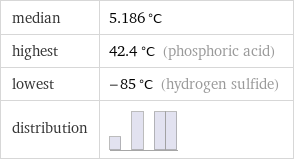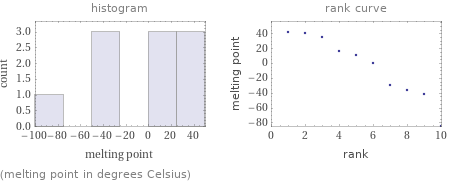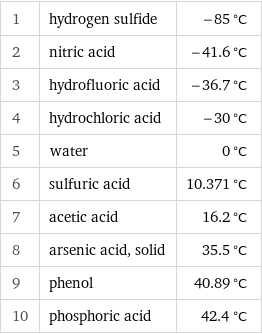Input interpretation

Brønsted-Lowry acids | melting point
Summary

median | 5.186 °C highest | 42.4 °C (phosphoric acid) lowest | -85 °C (hydrogen sulfide) distribution |
Distribution plots

(melting point in degrees Celsius)
Melting point rankings

1 | hydrogen sulfide | -85 °C 2 | nitric acid | -41.6 °C 3 | hydrofluoric acid | -36.7 °C 4 | hydrochloric acid | -30 °C 5 | water | 0 °C 6 | sulfuric acid | 10.371 °C 7 | acetic acid | 16.2 °C 8 | arsenic acid, solid | 35.5 °C 9 | phenol | 40.89 °C 10 | phosphoric acid | 42.4 °C
Unit conversions for median melting point 5.186 °C

278.3 K (kelvins)

41.33 °F (degrees Fahrenheit)

501 °R (degrees Rankine)

4.148 °Ré (degrees Réaumur)

10.22 °Rø (degrees Rømer)
Comparison for median melting point 5.186 °C

9.815 °C below temperature at STP (standard temperature and pressure), using the convention of European and South American natural gas companies (15 °C)

8.815 °C below average surface temperature of the earth (14 °C)

5.185 °C above temperature at STP (standard temperature and pressure), using the International Union of Pure and Applied Chemistry convention (0 °C)
Corresponding quantities

Thermodynamic energy E from E = kT: | 24 meV (millielectronvolts)

Blackbody energy flux Φ from Φ = σT^4: | 340 W/m^2 (watts per square meter)

Approximate luminous exitance from a planar blackbody radiator perpendicular to its surface: | 1.2×10^-23 lx (lux)